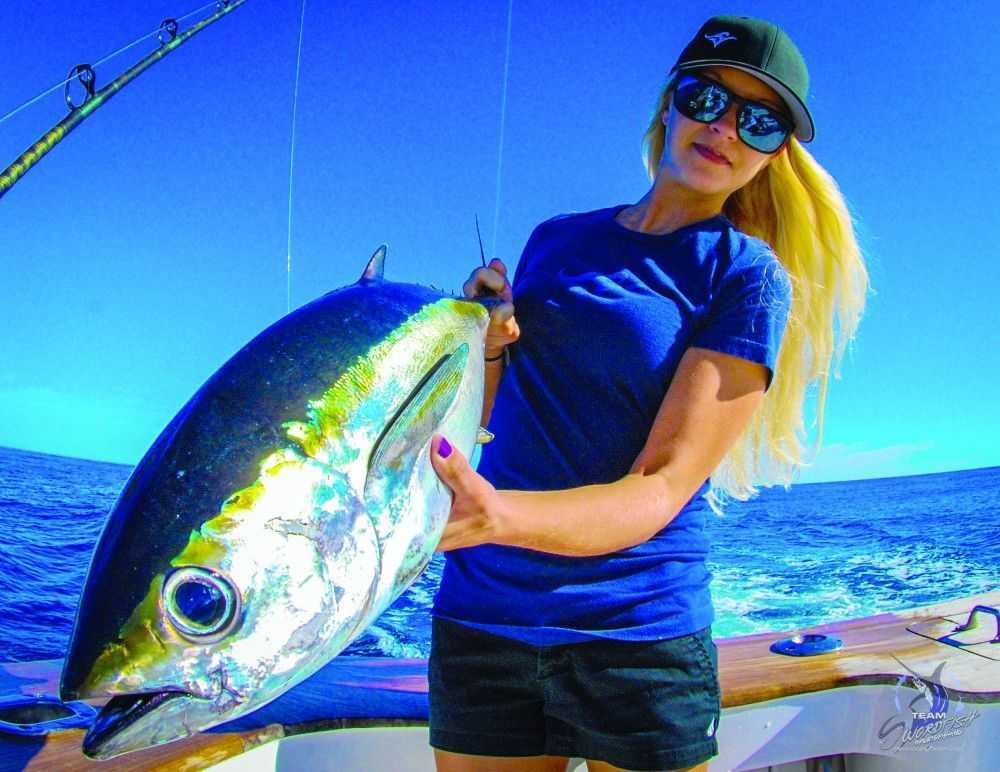With the TV show Wicked Tuna filming on the Outer Banks of North Carolina, the area’s bluefin tuna fishery has come into the spotlight on a worldwide stage. But the season for massive bluefins is short, lasting just a couple months in winter or early spring.
So what do offshore anglers on the Outer Banks do when the bluefin aren’t around? Brant Wise, owner of Swordfish Sportfishing out of Oregon Inlet, N.C., said the area’s proximity to the Gulf Stream and the edge of the Continental Shelf makes it an east coast hot spot for white marlin and sailfish. And it’s also home to what could be sportfishing’s ultimate meat trip. Yellowfin and big eye tuna inhabit these waters year-round, and Wise said the bite has been outstanding this year.
“Typically the yellowfin bite slows in the heat of summer, but this year has been consistent every month,” Wise said. “It has been really good.”
On average, yellowfin tuna boated by the fleet weigh in the 40- to 50-pound range, with 70- to 80-pound fish being big ones to get excited about.
This year has been different. Wise said four yellowfin ranging from 100 to 120 pounds were caught in a single week this spring. One of those fish, a 101-pounder was caught on his boat.
“That was a big fish, and it’s a rarity,” he said. “The biggest one before that was an 80-pounder.”
Another trend Wise has been glad to see is an increased presence of big eye tuna. In the past, big eye have been an incidental catch. He said on a good day with overcast skies and a northeast wind, one boat within the entire fleet might land a big eye.
“This year, every boat gets a big eye every day,” he said, “and sometimes five in a day.”
Bigeye tuna are larger than yellowfins, weighing up into the 200-pound range, and they put on a tremendous fight, especially because of the light 50- to 80-pound fluorocarbon leaders, it takes to fool them into biting.
“They’re as stubborn as an amberjack,” Wise said. “They’ll take their runs. And all the line you just got back… they’ll take it off the reel.”
It’s a test of wills right up until the fish, yellowfin or bigeye begins to flag and starts swimming the death circle under the boat. Then it becomes a race, with the mate timing the circles to gaff the fish before sharks get it. Wise said sharks have stolen more fish than usual this year.
But before landing fish, you have to find them. Wise begins his search 35 to 40 miles offshore on the edge of the Continental Shelf. He’s looking for bait. Currents and eddies will ball up bait, and even slight temperature or watercolor changes will hold baitfish. Birds are the standard dead-giveaway, but this year whales have led boats to a lot of fish.
“We’re looking for pilot and finback whales,” Wise said. “The tuna will be hanging beneath them picking up scraps.”
And when the tuna are found, yellowfin and bigeye will be feeding together. When targeting yellowfin, Wise pulls a spread with Sea Witches in “undisclosed colors” and medium or horse ballyhoo on a couple flat lines and longriggers. He’ll pull daisy chains of slick fish on his shortriggers and rig a long shotgun with a squid bar. A short shotgun will be loaded with another Sea Witch/ballyhoo, and most of these lines will be attached to 50-wides. For targeting bigeye, Wise gears up to 80 wides and cuts the number of lines out to six.
“It’s not uncommon to pull through a school and have 10 rods get knocked down,” Wise said, “and we’ve only got six anglers on the boat.”
But sometimes the bait balls stay down, and the fish won’t come up. In these situations, Wise and his anglers will tie on spoons and try to jig up the tuna.
“Imagine hooking into a VW Beetle when you yank that rod up and the fish tries to pull the rod out of your hands,” Wise said. “Pound for pound, they are some of the toughest fighting fish.”
One other technique that brings a lot of excitement to the deck is for when the fish are up but ignoring trolled baits. In situations like these, it’s time to pull out the greenstick. The greenstick is a tall pole extending upward in the center of the boat that serves at kind of an outrigger for one line out of the back of the boat. On that line is a “bird,” which skims near the surface and attracts tuna but also provides tension for the rest of the rig. Baited lines are run from the rods and attached to the line holding the bird with release clips.
The result is multiple baits skimming along behind the boat just above the surface of the water. As the baits dip in and out of the water, Wise said it mimics a school of flying fish. When a tuna hits, the baited line releases from the rig, and the fight is on. It’s the solution when tuna are leader-shy or if they are keyed in on flying fish.
“Seeing tuna fly out of the water to hit those baits creates a lot of excitement,” Wise said. To many, that might seem to be a bit of an understatement.
In a typical year, the bite for yellowfin and big eye slows in August and September and picks up again in late September or October. Late fall and into the spring, blackfin tuna show up on the Outer Banks.
Swordfish Sportfishing would be happy to take you out to fill your freezer with tuna or tangle with marlin, sailfish, and many other offshore species. Swordfish Sportfishing operates out of OBX Marina on the Outer Banks of North Carolina’s Oregon Inlet. See their website www.swordfish-obx.com or call (757)-236-5000.
